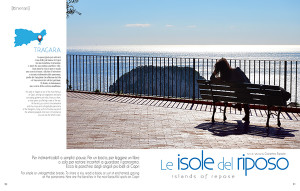 Le isole del riposo | Islands of repose
Le isole del riposo | Islands of repose
foto di | photos by Costantino Esposito
Per indimenticabili o semplici pause. Per un bacio, per leggere un libro o solo per restare incantati a guardare il panorama. Ecco le panchine degli angoli più belli di Capri. | For simple or unforgettable breaks. To share a kiss, read a book, or just sit enchanted, gazing at the panorama. Here are the benches in the most beautiful spots on Capri.
Tragara
La passeggiata per arrivarci è una delle più famose di Capri tra una rigogliosa vegetazione e muri che nascondono giardini e ville.
Ogni tanto la vista si apre e regala uno scorcio di mare. Alla fine il belvedere e un unico indimenticabile panorama, quello dei Faraglioni che affiorano dal blu e il rincorrersi dei voli dei gabbiani. Di fronte, in lontananza, uno scorcio della costiera amalfitana. | The walk to Tragara is one of the most famous on Capri, among lush vegetation and walls concealing gardens and villas. Every so often, a vista opens up offering a view of the sea. At the end, you come to the belvedere and the unique and unforgettable panorama of the Faraglioni, rising up from the blue sea amid the wheeling seagulls. And over in the distance you can see the Amalfi coast.
Cetrella
Capri è laggiù, come un grande presepe, e i Faraglioni da qui sembra poterli prendere in una mano. Intorno, mare e cielo che si fondono insieme. Dopo una sosta vale la pena visitare l’eremo di Santa Maria a Cetrella aggrappato a un precipizio a strapiombo su Marina Piccola.
Risale al XV secolo e il luogo era caro soprattutto ai marinai che usavano salire in pellegrinaggio alla chiesetta prima delle pericolose spedizioni per la raccolta del corallo.
Da maggio a settembre si può visitare un paio di volte alla settimana grazie a Ottavio e Carmine Ruocco, i due fratelli che se ne occupano dal 1971. | Capri is down there, like a big nativity scene model, and from here it feels as though you could hold the Faraglioni in one hand. All around, the sea and sky blend into each other. After stopping off here, it’s worth making a visit to the hermitage of Santa Maria at Cetrella, that clings to a precipice high above Marina Piccola. It dates back to the 15th century and is especially venerated by sailors, who used to climb up to the little church in pilgrimage before setting off on their perilous expeditions to collect coral.
From May to September you can visit a couple of times a week, thanks to Ottavio and Carmine Ruocco, the two brothers who have been looking after it since 1971.
Parco Astarita
Un susseguirsi di terrazze a picco sul mare tra la macchia mediterranea e antichi pini marittimi che si affacciano a strapiombo sul mare profondo delle Bocche di Capri. Ginepri, rosmarini, mirti e cespugli di lauro sono i protagonisti di questo polmone verde che si estende per circa 150.000 metri quadrati e offre dei panorami mozzafiato.
Donato al Comune di Capri dal banchiere Mario Astarita che lo aveva voluto per salvaguardare la flora dell’isola e che qui vicino aveva fatto edificare il suo ritiro spirituale, Villa La Falconetta. Si può visitare fino al 31 ottobre, dalle 10:00 alle 18:00. | A series of terraces among the Mediterranean scrub and the ancient maritime pines that look down from sheer cliffs onto the depths of the Bocche di Capri straits. Juniper, rosemary, myrtle and bay are the main plants to be found in this green lung, that covers about 150,000 square metres and offers a breathtaking view. It was donated to the Comune of Capri by banker Mario Astarita, who commissioned it in order to protect the island’s flora, and whose spiritual retreat, Villa La Falconetta, was built nearby.
It can be visited until 31 October, from 10AM to 06PM.
Funicolare
Alle spalle il teatro della Piazzetta, di fronte il massiccio del Solaro e sulla destra la silhouette di Ischia incorniciata da bianche colonne. Uno spettacolo sempre, sia quando tramonta il sole sia quando per tetto arrivano le stelle. | Funicular. Behind you is the theatre of the Piazzetta, opposite the bulky outline of Monte Solaro, and on the right the silhouette of Ischia framed by white columns. It’s always an amazing sight, whether at sunset or with a canopy of stars above your head.
Giardini di Augusto
Nascono nell’antica proprietà che l’industriale tedesco Friedrich Alfred Krupp acquistò nei primi anni del Novecento a ridosso della Certosa di San Giacomo per costruire la sua dimora caprese. Dopo la prima guerra mondiale furono ribattezzati “i giardini di Augusto” e vi sono custodite le principali specie di fiori che si possono trovare sull’isola. In alcuni mesi dell’anno i tramonti da qui sono indimenticabili. Dal primo marzo al 15 novembre l’ingresso costa 1 euro e l’orario per la visita è dalle 9:00 alle 19:30. | Augustus Gardens. They are concealed in the old property that the German industrialist Friedrich Alfred Krupp bought in the early years of the 20th century, behind the Certosa di San Giacomo, to build his Capri home. After the First World War, they were renamed “the gardens of Augustus” and they contain all the principal species of flower to be found on the island. In some months of the year, you can see some unforgettable sunsets from this spot. From 1 March to 15 November the entrance fee is 1 euro and the opening times are from 9AM to 07.30PM.
Torna a sommario di Capri review | 35




